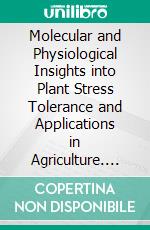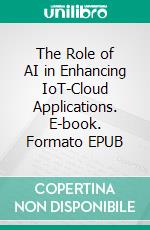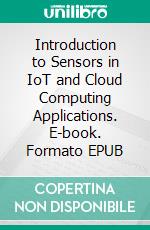Ambika Nagaraj eBooks
eBooks di Ambika Nagaraj
Molecular and Physiological Insights into Plant Stress Tolerance and Applications in Agriculture. E-book. Formato EPUB Ambika Nagaraj - Bentham Science Publishers, 2023 -
Molecular and Physiological Insights into Plant Stress Tolerance and Applications in Agriculture is an edited volume that presents research on plant stress responses at both molecular and physiological levels. Key Features: - Emphasizes the morphological and physiological reactions of plants and the underlying molecular mechanisms when faced with stress from environmental or pathogenic factors. - Explores microbial dynamics within the plant rhizosphere and the application of plant growth-promoting bacteria as biofertilizers and endophytes as biocontrol agents to enhance crop growth and productivity for sustainable agriculture. - Systematically summarizes molecular mechanisms in plant stress tolerance and discusses the current applications of biotechnology, nanotechnology, and precision breeding to obtain stress-tolerant crops, contributing to climate-smart agriculture and global food security. - Includes contributions and references from multidisciplinary experts in plant stress physiology, plant molecular biology, plant biotechnology, agronomy, agriculture, nanotechnology, and environmental science. The content of the book is aimed at addressing UN SDG goals 2, 12, and 15 to achieve zero hunger and responsible consumption and production, and to sustainable use of terrestrial ecosystems, respectively. This comprehensive resource is suitable for researchers, students, teachers, agriculturists, and readers in plant science, and allied disciplines. Readership: Researchers, students, teachers, agriculturists, and readers in plant science, and allied disciplines.
The Role of AI in Enhancing IoT-Cloud Applications. E-book. Formato EPUB Ambika Nagaraj - Bentham Science Publishers, 2023 -
This book explores the dynamic intersection of three cutting-edge technologies—Artificial Intelligence (AI), Internet of Things (IoT), and Cloud Computing—and their profound impact on diverse domains. Beginning with an introduction to AI and its challenges, it delves into IoT applications in fields like transportation, industry 4.0, healthcare, and agriculture. The subsequent chapter explores AI in the cloud, covering areas such as banking, e-commerce, smart cities, healthcare, and robotics. Another section investigates the integration of AI and IoT-Cloud, discussing applications like smart meters, smart cities, smart agriculture, smart healthcare, and smart industry. Challenges like data privacy and security are examined, and the future direction of these technologies, including fog computing and quantum computing, is explored. The book concludes with use cases that highlight the real-world applications of these transformative technologies across various sectors. Each chapter is also supplemented with a list of scholarly references for advanced readers.The book is intended primarily as a resource for students in information technology and technology courses. And as a secondary resource for industry professionals who want to learn about these technologies in the context of digital transform
Introduction to Sensors in IoT and Cloud Computing Applications. E-book. Formato EPUB Ambika Nagaraj - Bentham Science Publishers, 2021 -
Introduction to Sensors in IoT and Cloud Computing Applications provides information about sensors and their applications. Readers are first introduced to the concept of small instruments and their application as sensors. The chapters which follow explain Internet of Things (IoT) architecture while providing notes on the implementation, demonstration and related issues of IoT systems. The book continues to explore the topic by providing information about sensor-cloud infrastructure, mobile cloud, fog computing (an extension of cloud computing that takes cloud computing to the cutting-edge of networking where data is produced) and integration of IoT devices with cloud computing. The book also presents notes on the taxonomy of fog-computing systems. The six chapters in this book provide essential information for general readers, and students of computer science to understand the basics of cloud computing networks, related concepts and applications.


